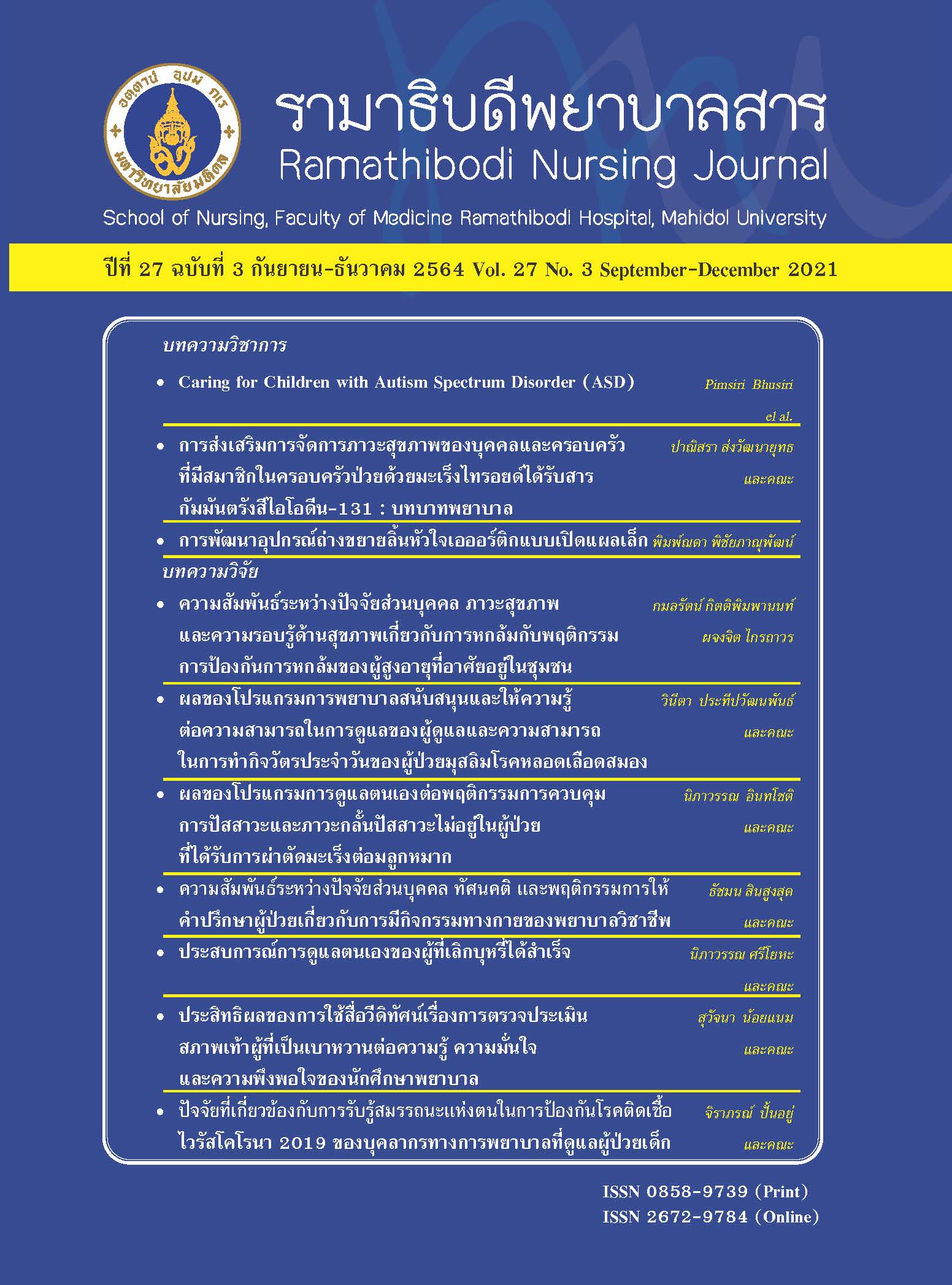Factors Related to Perceived Self-Efficacy for COVID-19 Prevention in Pediatric Nursing Staff
Main Article Content
Abstract
This descriptive research aimed to examine factors related to perceived self-efficacy for coronavirus disease 2019 (COVID-19) prevention and explore the needs and barriers to COVID-19 prevention in a sample of 227 pediatric nursing staff at Ramathibodi Hospital. The research instruments for data collection consisted of a demographic form, the Knowledge Questionnaire about COVID-19 Prevention, and the Perceived Self-efficacy for COVID-19 Prevention Assessment Scale. Quantitative data were analyzed using descriptive statistics and Spearman’s Rho correlation. An in-depth interview was conducted with 30 pediatric nursing staff in Pediatric Department, and qualitative data were analyzed using content analysis. The finding showed that the pediatric nursing staff had a high level of knowledge and perceived self-efficacy scores for COVID-19 prevention. Knowledge was positively and significantly associated with perceived self-efficacy for COVID-19 prevention of pediatric nursing staff. The findings from in-depth interview showed that the problem or barriers for COVID-19 prevention among pediatric nursing staff included: 1) changing policy or practice guidelines, 2) a limited number of professionals for patient care, 3) shortage of personal protective equipment, 4)communication problems, and 5) lack of co-operation of pediatric patients in their practice. Moreover,the pediatric nursing staff had the needs about COVID-19 prevention: 1) sufficiency of personal
protective equipment and 2) training for updated knowledge of COVID-19 prevention and the use of personal protective equipment. Consequently, the organization should prepare sufficient personal protective equipment, provide on-demand knowledge continuously, and impose clear policy or guidelines for COVID-19 prevention in pediatric nursing staff.
Keywords: Knowledge, Perceived self-efficacy, COVID-19 prevention, Personal protective equipment, Pediatric nursing staff
Article Details

This work is licensed under a Creative Commons Attribution-NonCommercial-NoDerivatives 4.0 International License.
บทความ ข้อมูล เนื้อหา รูปภาพ ฯลฯ ที่ได้รับการตีพิมพ์ในรามาธิบดีพยาบาลสาร ถือเป็นลิขสิทธิ์ของวารสาร หากบุคคลหรือหน่วยงานใดต้องการนำทั้งหมดหรือส่วนหนึ่งส่วนใดไปเผยแพร่หรือเพื่อกระทำการใด ใด จะต้องได้รับอนุญาตเป็นลายลักษณ์อักษรจากรามาธิบดีพยาบาลสารก่อนเท่านั้น
References
World Health Organization. COVID19 strategy. Geneva,Switzerland: World Health Organization; 2020.
Department of Disease Control. Coronavirus disease (COVID-19). [cited 2020 May 21]. Available from:
https://ddc.moph.go.th/viralpneumonia/ (in Thai)
Dong Y, Mo X, Hu Y, Qi X, Jiang F, Jiang Z, et al.Epidemiology of COVID-19 among children in China.
Pediatrics. 2020;145(6):1-10.
Center for Disease Control and Prevention. Bridged-race population estimates 2020. [cited 2020 May 21].
Available from: https://wonder.cdc.gov/bridged-racepopulation.html
Department of Disease Control. Situation of coronavirus disease (COVID-19). [cited 2021 May 21]. Available
from: https://ddc.moph.go.th/viralpneumonia/eng/index.php (in Thai)
Department of Disease Control. Situation of coronavirus disease (COVID-19). [cited 2021 August 31]. Available
from: https://ddc.moph.go.th/viralpneumonia/file/situation/situation-no541-270664.pdf (in Thai)
He J, Liu L, Chen X, Qi B, Liu Y, Zhang Y, Bai J. The experiences of nurses infected with COVID-19 in Wuhan,
China: A qualitative study. J Nurs Manag. 2021 Jul;29(5):1180-8. doi: 10.1111/jonm.13256
Department of Disease Control. Personal Protective Equipment (Issue dated 20 April 2020). [cited 2021
May 21]. Available from: https://ddc.moph.go.th/viralpneumonia/file/g_health_care/g07_ppe_200463.
pdf (in Thai)
Preutthipan A. Guidelines for respiratory therapy in pediatric patients infected with COVID-19 (6 April
[cited 2021 May 21]. Available from: https://www.thaipediatrics.org/Media/media-202004091
pdf (in Thai)
Alsahafi AJ, Cheng AC. Knowledge, attitudes, and behaviours of healthcare workers in the Kingdom of Saudi
Arabia to MERS coronavirus and other emerging infectious diseases. Int J Environ Res Public Health. 2016;13(12):
doi: 10.3390/ijerph13121214
Bandura A. Self-efficacy: the exercise of control. New York: WH Freeman; 1997.
Simak VF, Kristamuliana K. The relationship between knowledge of the use of personal protective equipment and the self efficacy of puskesmas nurses againt Covid-19 management. Int J Nurs Midwifery. 2020;4(2):156-
Dadfar M, Sanadgol S. Self-efficacy on the Coronavirus disease-2019 (COVID-19). (preliminary report). [cited
October 13]. Available from: https://www.researchsquare.com/article/rs-143799/v1
Benight CC, Bandura A. Social cognitive theory of posttraumatic recovery: the role of perceived self-efficacy.
Behav Res Ther. 2004;42(10):1129-48.
Bandura A. The explanatory and predictive scope of selfefficacy theory. J Soc Clin Psychol. 1986;4(3):359-73.
Soudagar S, Rambod M, Beheshtipour N. Factors associated with nurses’ self-efficacy in clinical setting in
Iran, 2013. Iran J Nurs Midwifery Res. 2015;20(2):226-31.
Kurnia TA, Trisyani Y, Prawesti A. Factors associated with nurses’ self-efficacy in applying palliative care in
intensive care unit. Jurnal Ners. 2019;13(2):219-26.
van der Weerd W, Timmermans DR, Beaujean DJ, Oudhoff J, van Steenbergen JE. Monitoring the level of government trust, risk perception and intention of the general public to adopt protective measures during the influenza A (H1N1)pandemic in the Netherlands. BMC Public Health.2011;11(1):1-12.
Nakhaee M, Alinejad MS. Investigating nurses’ knowledge and self-efficacy regarding the principles of infection control in the operating room. Mod Care J.2015;12(2):79-83.
Desiani S, Nuraeni A, Priambodo AP. How do knowledge and self-efficacy of internship nursing students in
performing cardiopulmonary resuscitayion?. Belitung Nurs J. 2017;3(5):612-20.
Handiyani H, Kusumawati AS, Karmila R, Wagiono A,Silowati T, Lusiyana A, et al. Nurses’ self-efficacy in
Indonesia. Enferm Clin. 2019;29:252-6.


